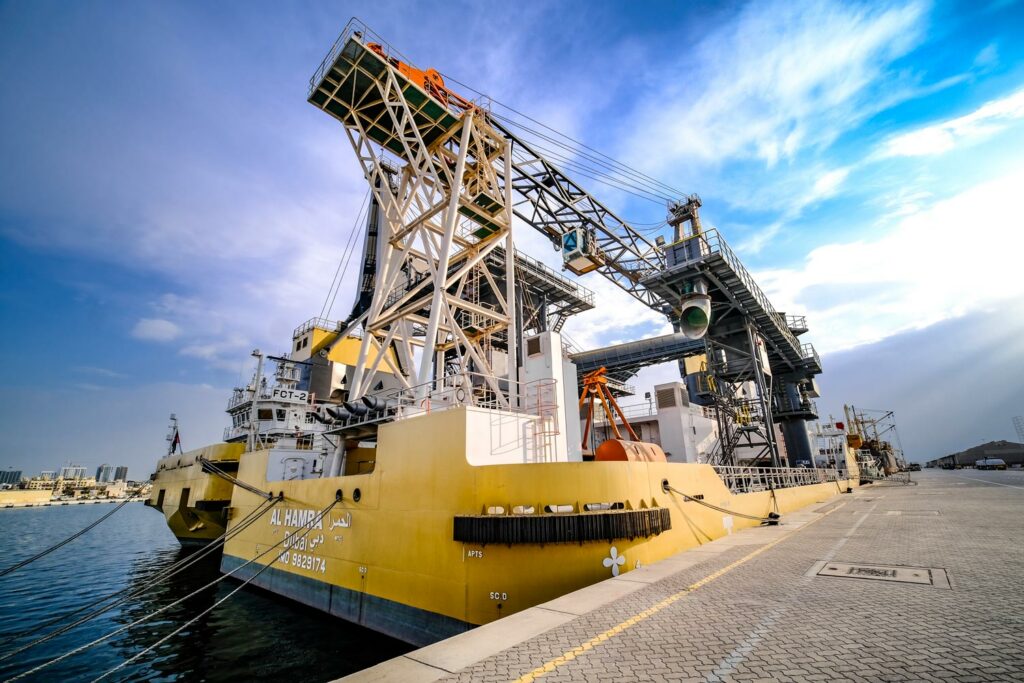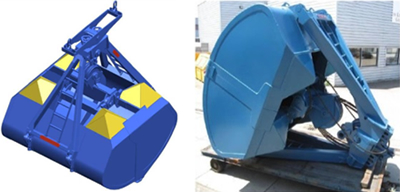Floating Crane Transhipper Units
LD Ports & Logistics – Floating cranes are the result of the extensive experience gained over these years.

Technologically advanced transshipment vessel
FCTU are technologically advanced, self-propelled transshipment vessels. They are developed as an innovative solution to allow an efficient, reliable and safe off-shore transfer of cargo, with capabilities to realize most of the critical repair and maintenance autonomously.
They serve as an excellent tool for off-shore loading and unloading of ocean going vessels, including capsize and Newcastlemax. The FCTU 42T model is equipped with an unloading arm to enhance the transshipment rate, providing a free-digging rate of 38,000TPD.
FCTU has been designed to be operated entirely by local crews. After a short training local workforce can be employed to work on the FCTU. Equipment onboard has been selected to avoid extensive and complicated maintenance:
Their all DC current power supply does not require the extensive maintenance time and cost needed on similar hydraulic cranes.
The absence of complicated conveyor systems dramatically lowers maintenance costs and ensures proper handling of cargo with high-moisture content at low cost.
Floating Crane Transshipper Units are developed as a solution to allow the massive transshipment of dry bulk commodities using the grab-based handling systems such as coal, bauxite and iron ore. They can be operated with barge and tugs, self-propelled barges or sea-river coaster vessels.
FCTU provides full accommodation for the crew who will be on board 24(hrs)/7(days). This ensures round the clock operations with the exception of planned maintenance.
FCTU ensures true performance as it is designed out of the engineering ingenuity skills of LDPL, which commands 20 years of extensive experience in transshipment operations.
The lattice boom crane is designed to optimize the frame’s stress capacity. This enhances rigidity while reducing weight, which contributes greatly to its exceptional lifting capacity and optimizes dynamic performance.
Its fully redundant power system features a programmable logic controller that can control the power outputs to grant the FCTU an unrivaled reliability to unleash true performance unimpeded by any wave conditions.
FCTU has been designed to perform with the simplest motionsand the least amount of moving parts possible. Their design has been completed without resorting to hydraulic systems, thereby lengthening their life expectancy.
Operations limits
The maximum wind speed under which the FCTU can safely operate is 20m/sec, Beaufort 8.
FCTU can safely operate with a maximum wave height of 5.5m. FCTU are fitted with load cells and data loggers in order to monitor load accelerations and variation. Load cells are linked to a PLC which supersedes operator’s actions by adjusting whenever necessary hoisting speed in order to remain all time within safe structural limits of the FCTU.
History
At the brink of the 90s’ Louis Dreyfus Armateurs realized that the economic development of certain countries in South East Asia and South America would largely depend on port infrastructures.
In order to avoid costly fixed investments which would only be possible under a strong economic growth, LDA developed an innovative solution to allow massive exports of dry bulk commodities from these areas. Thus, in 1989 LDA acquired and operated for Adaro its first floating crane transhipper units. For more than 20 years LDA has been operating floating cranes, acquiring an essential know-how in off-shore transhipment. LD Ports & Logistics floating cranes are the result of this extensive experience gained over these years.
Principal particulars
| Length o.a. | 56.40 m |
|---|---|
| Beam mld | 24.00 m |
| Depth at sides | 5.23 m |
| Draught design | 2.93 m |
| Displacement | 3,100 t |
| Gross tonnage | 2,148 GT |
| Maximum Working Radius | 40.00 m |
| Minimum Working Radius | 17.00m |
| Hoisting speed | 0-105 m/min |
| Luffing time | 30 sec |
| Slewing speed | 0-1.44 rpm |
Loading rates
The design of our Floating Crane Transhipper Units has been optimized to perform high transshipment rates in loading and unloading all types of vessels, Capesize or Panamax. LDPL has developed its own brand new crane piloting software to optimize crane operating motions while handling bulk at sea. Speeds of hoisting and luffing motions are permanently monitored and adapted to the sea-state in order to maximize the transshipment rate.
| SWL @40m | Free-gigging rate |
|---|---|
| 42T + loading arm | 1,600 tph 38,000 TPD |
| 42T | 1,380 tph 33,000 TPD |
| 36T 1,180 tph | 1,180 tph 28,000 TPD |
| 32T | 1,050 tph 25,000 TPD |
Antipollution devices:
1.Anti-pollution Grab:
highly enclosed and heavy duty clamshell grabs for optimal performance and control of dust emission. The highly enclosed shell minimizes the influence of wind on the coal inside the grab. The grab is fitted with steep plates to ensure that the cargo will not be compressed within it.

If the FCTU is fitted with an unloading arm and a hopper (for Ocean Going Vessel unloading only) additional anti-pollution devices can be fitted to the FCTU:
2. Hopper with dust suppression systems:
Flex-Flap type mechanical system has angled steel plates keep the dust within the hopper. The cargo drops from the grab, passes through a protective grid by opening the vertical flaps and flowing over the angled plates. The flaps fall back into their closed position once the cargo has dropped through, trapping the dust inside the hopper.
The hopper can also be fitted with atomized fresh water jets to create a continuous water spray barrier that encompasses the dust when the grab is opening. The water droplet size is matched as closely as possible to the cargo dust particles suspended in the air, combining the water and dust particles to add weight and bring the dust particles down into the hopper where they are trapped by the Flex-Flap system. Each FCTU generates her own fresh water reserve through reverse osmosis process and is fitted with a water drainage collection and treatment system on board.
Antipollution plates: The hopper will also be provided with anti-pollution plates that are deployed while in operation to prevent coal losses onto the deck.

3. FCTU – Enclosed conveyor and engineered-flow loading chute
The FCTU is equipped with a fully enclosed conveyor to provide maximum control of fugitive airborne dust emissions. The telescopic arm loading system (telestack or equivalent) includes an engineered loading chute to suppress the dust to the minimum while unloading coal into the barge. The engineered-flow transfer chute is installed to ensure an optimized flow transfer between the conveyor and cargo space. In the chute, the coal is kept as a tight, coherent stream, the amount of induced air is minimized with no exposure to wind as well. Less air is released and less airborne dust created.

